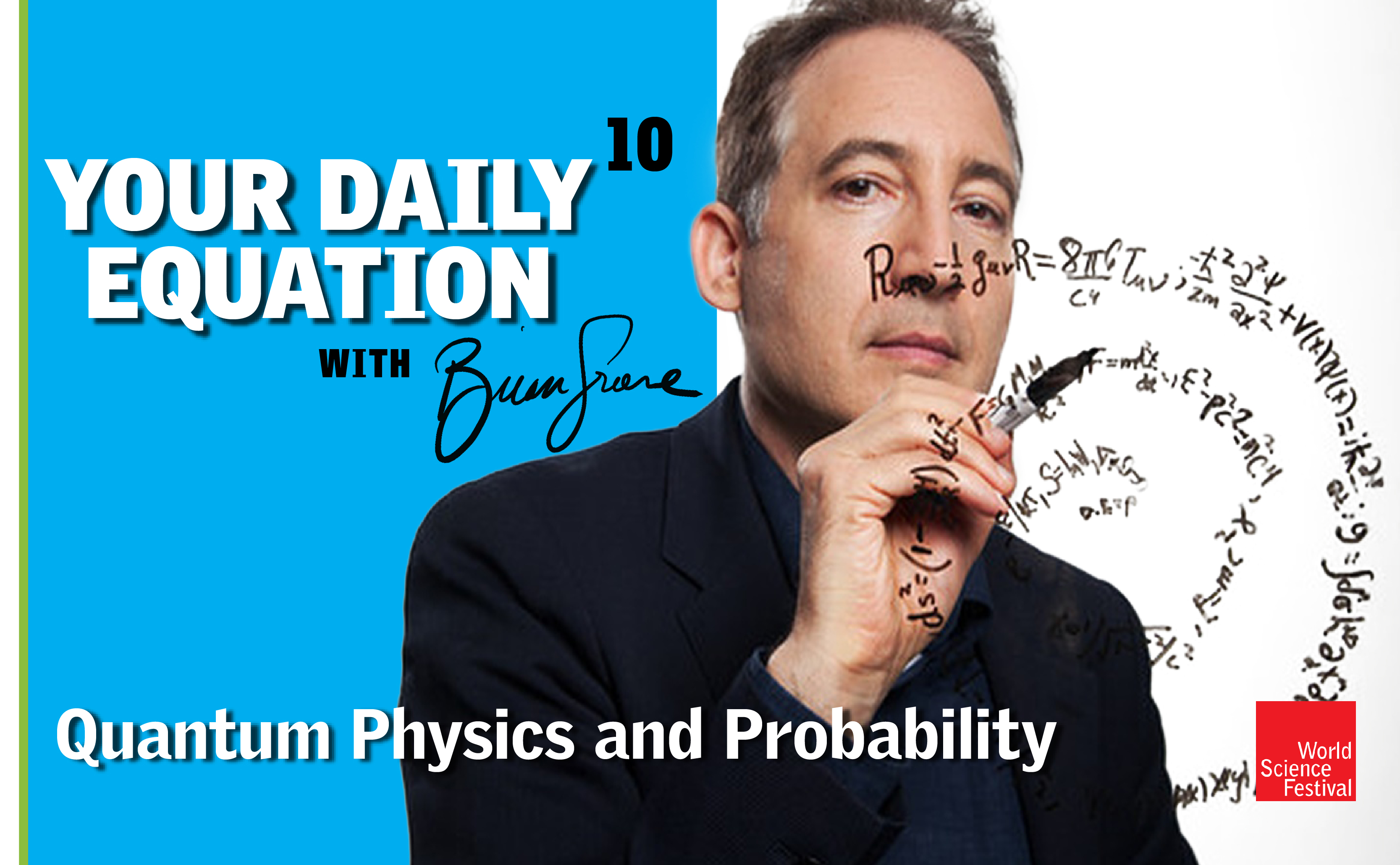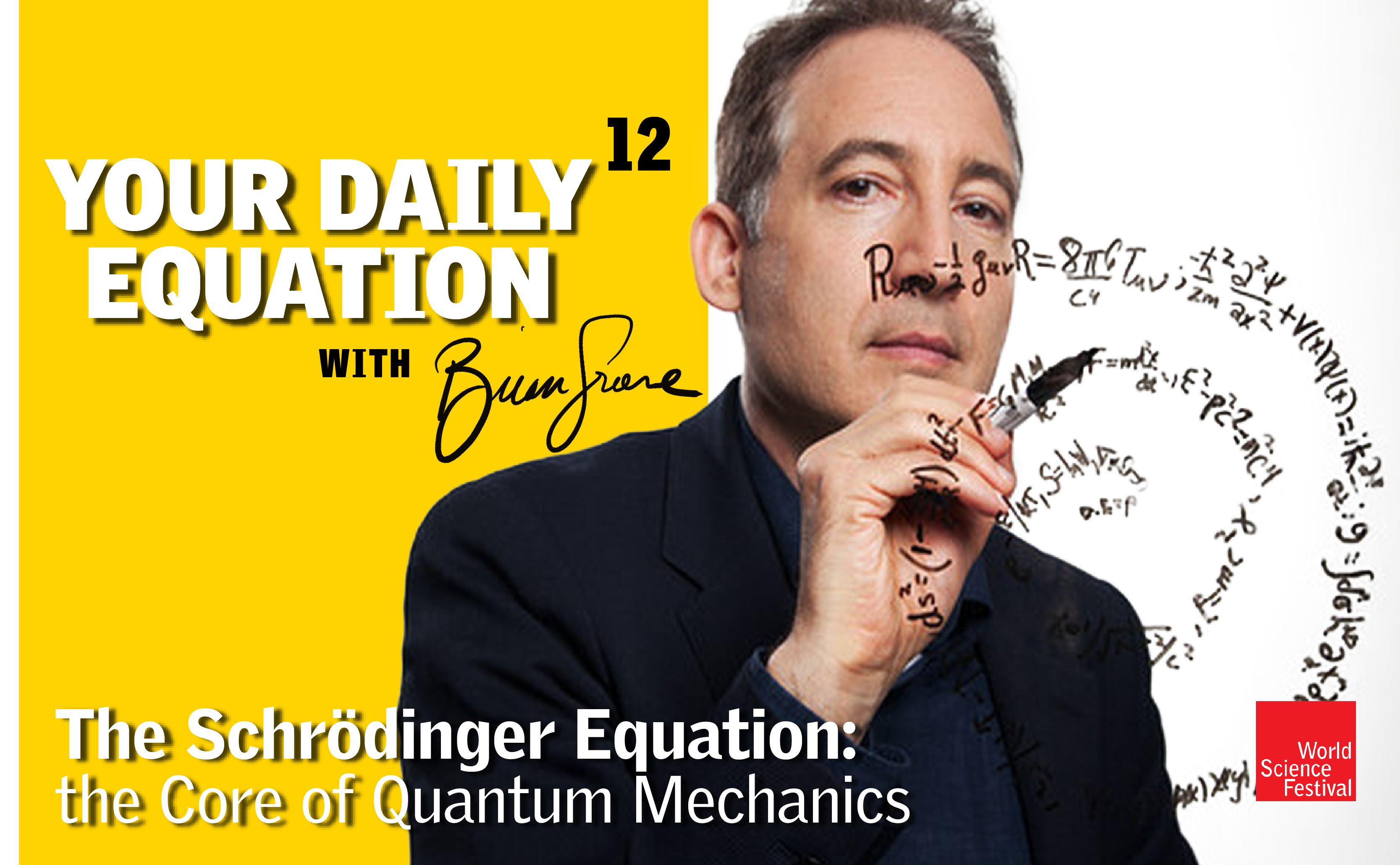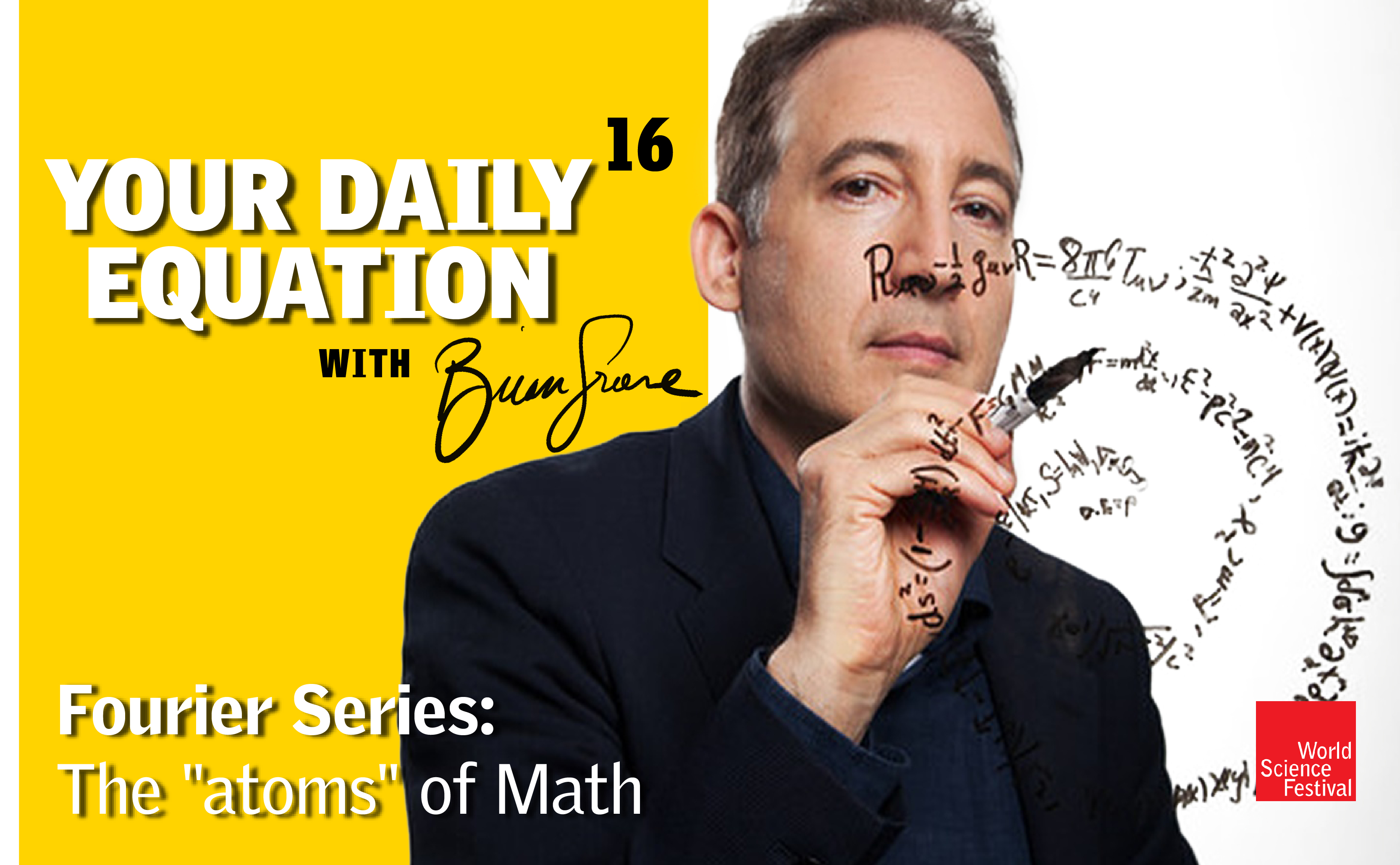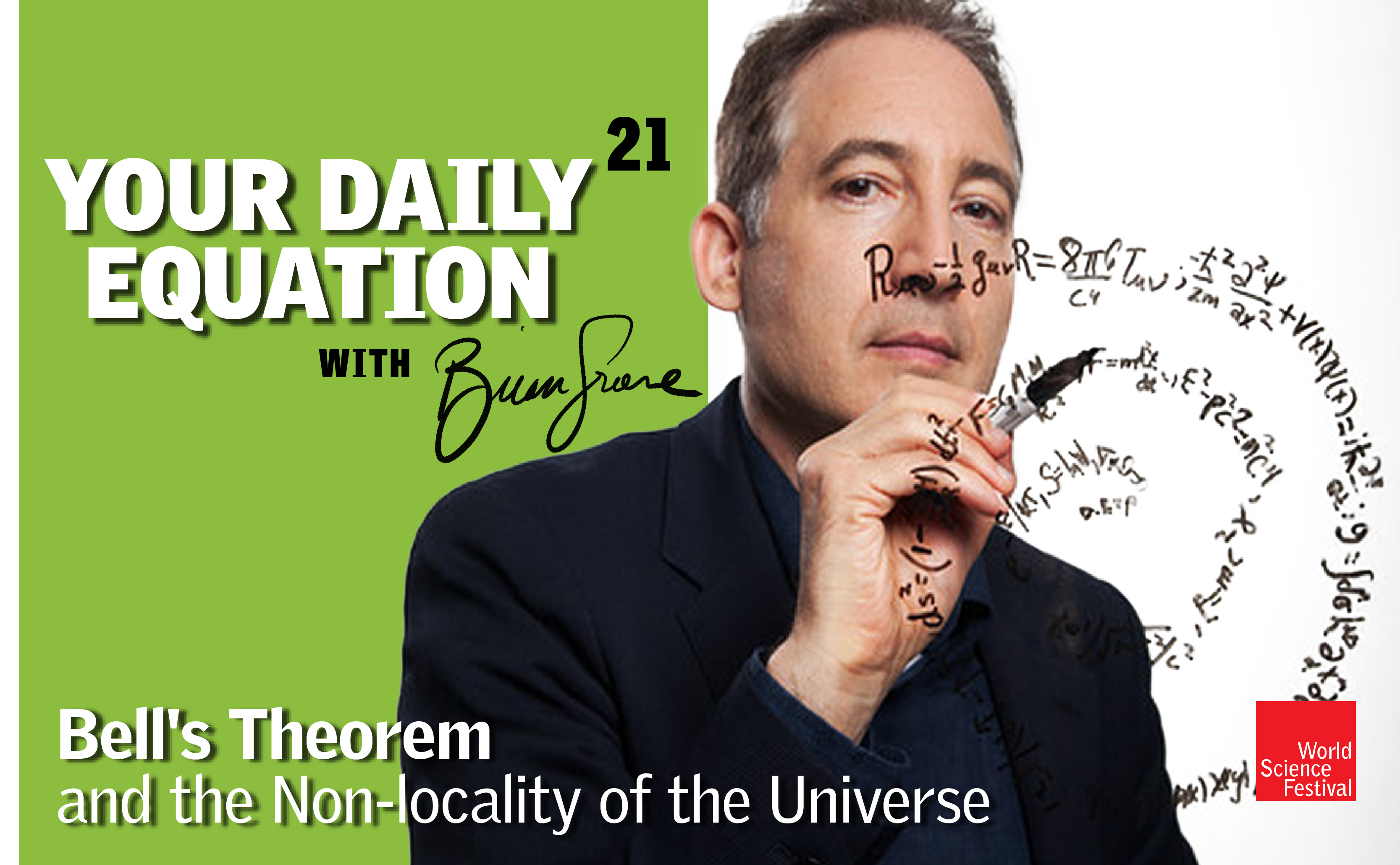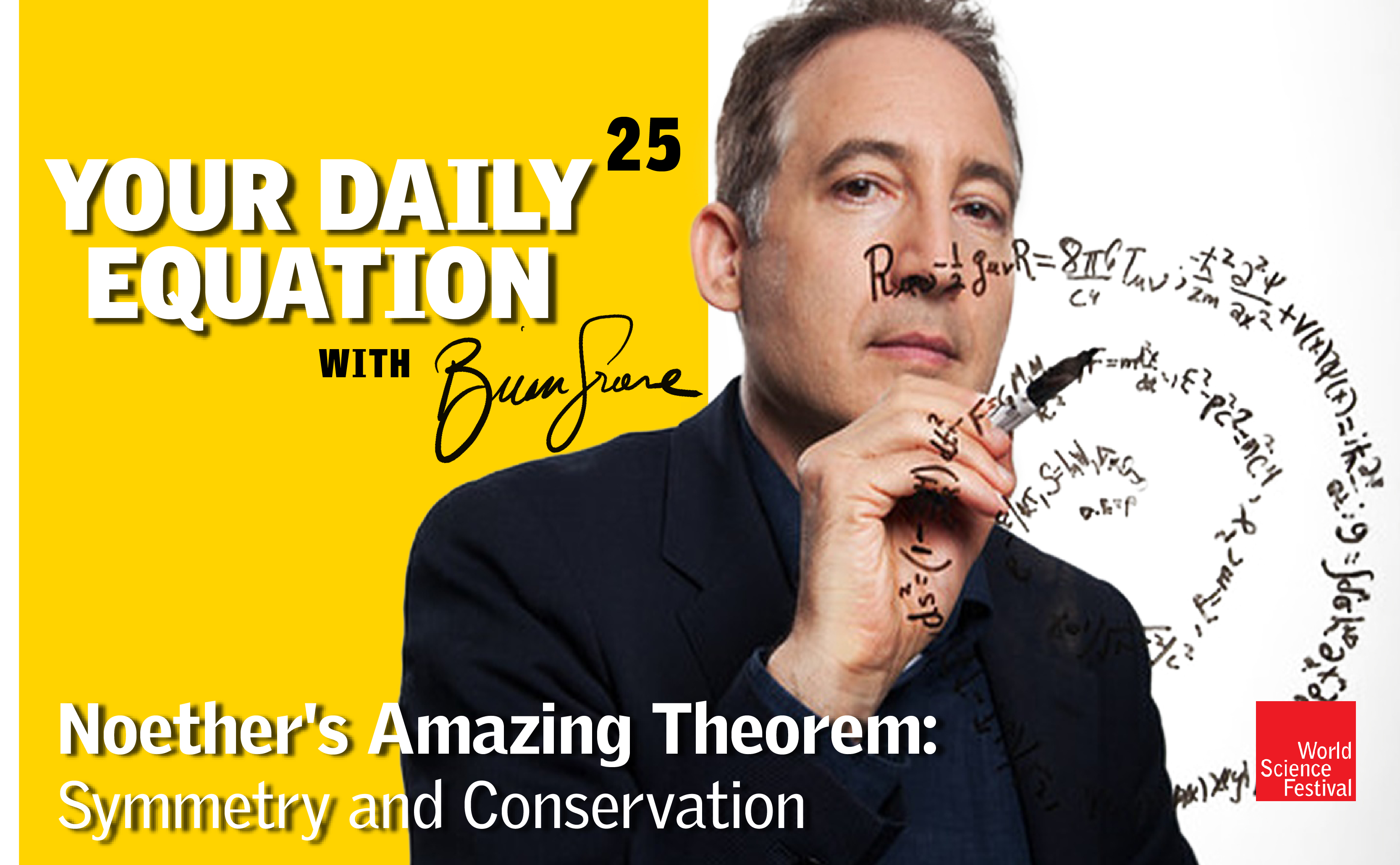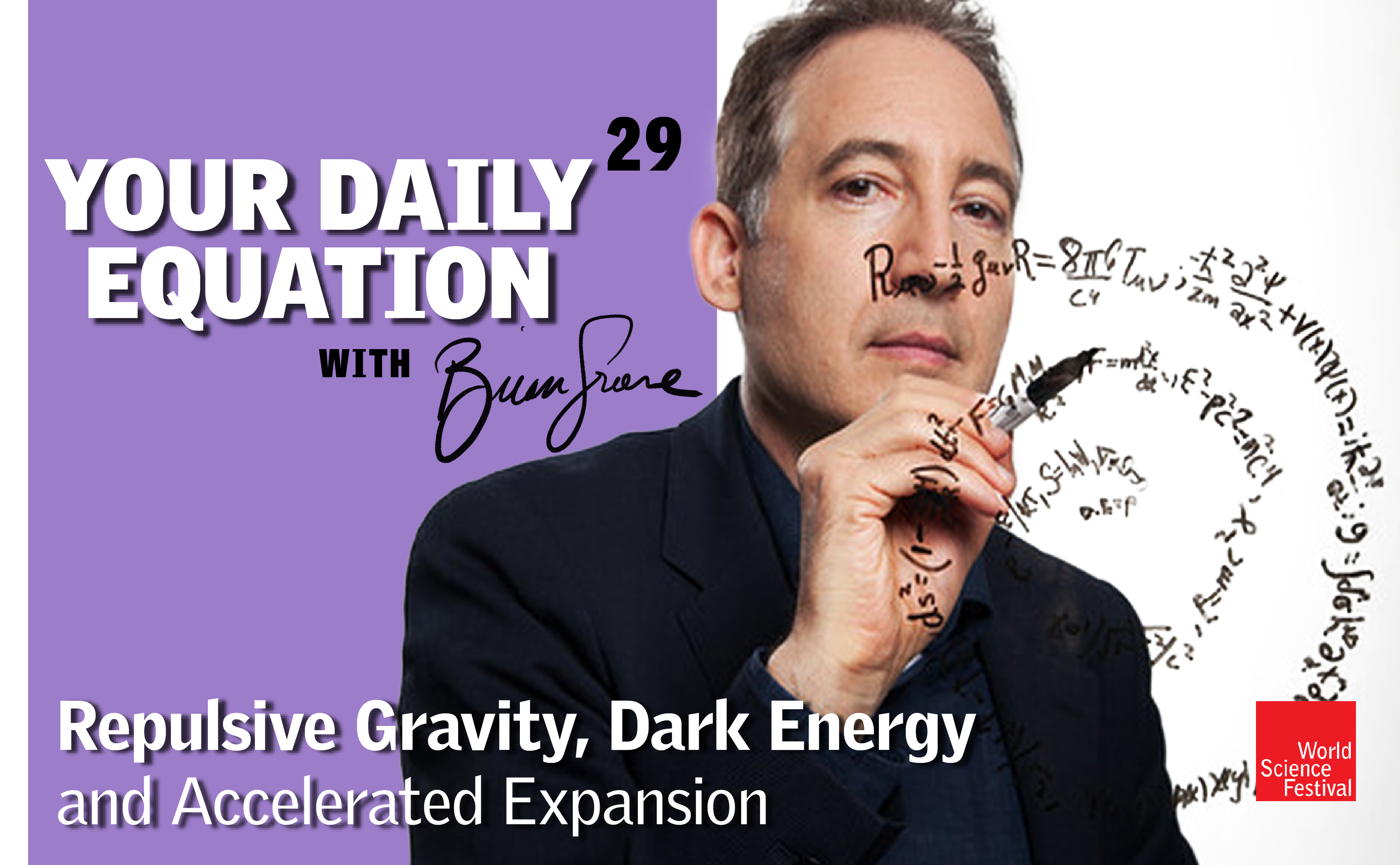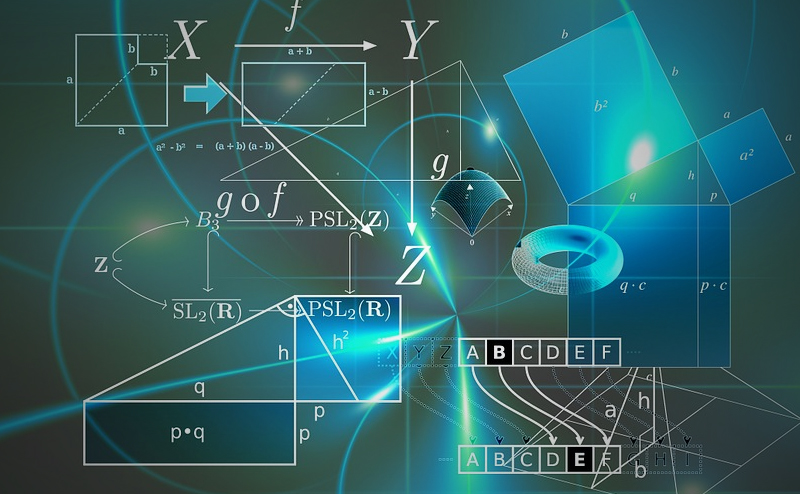3,901 views | 00:12:06
#YourDailyEquation with Brian Greene offers brief and breezy discussions of the most pivotal equations of the ages. Even if your math is a bit rusty, these accessible and exciting stories of nature and numbers will allow you to see the universe in a new way. The series includes live Q+As that explore many of the big questions that have occupied some of the greatest thinkers of our age and yielded some of the deepest insights into the nature of reality. Episode 15 #YourDailyEquation The Planck scale is often described as the arena in which both quantum mechanical and gravitational effects come into play. The Planck length is tiny (compared to the sizes of everyday things) and the Planck mass is huge (compared to the mass/energy of elementary particles). In this episode of Your Daily Equation, join Brian to understand where the Planck values come from.Learn More
Speaker 1:
Hey everyone, welcome to your daily equation and today I’m going to focus on an equation that as you will see is mathematically quite simple, involves nothing more than algebra and yet it helps us gain insight into the answer to a question that I’m frequently asked. Maybe it’s a question that has occurred to you as well, which is people say to me, hey, when are you finally going to test string theory? And the answer I have to give is look in principle string theory makes predictions.
In principle, any theory that puts gravity and quantum mechanics together that’s worth its salt makes predictions. The problem, the challenge is that the predictions require us to access realms of reality that are quite extreme, very, very tiny lane scales, very, very large mass scales, large energies, and we just don’t have the technology to access those extreme realms and if the person is particularly inquisitive, they’ll go further and say like how small lane scales, how big are the mass scales?
And I’ll tell them, look, on the order of 10 to the minus 33 centimeters, really tiny length or on the order of 10 to the 19 times the mass of the proton with John particle physics scales is enormous and if the person is not particularly inquisitive, they’ll nod their head and say, okay, I get it.
But if they run a push further, they’ll say, tell me where you get 10 to the minus 33 centimeters. Like where does that number come from? Where does 10 to the 19 times the mass of the proton come from? Or an analogous question is, how far can we turn back the cosmic film of the big bang to get a glimpse mathematically of the very beginning of the big bang? The answer there is you can turn the film back to about, in principle, about 10 to minus 43, 10 to the minus 44 seconds. The Planck time, again, a very tiny, tiny timescale. Where do these numbers come from? And these numbers are known as the Planck length, the Planck mass, the Planck time. So that’s our subject for today. I want to derive for you, bring this up on the screen. I want to derive for you the so-called Planck length.
As well as I’ll quickly do Planck mass and the Planck time and again, as you’ll see, nothing more than algebra is required for this, but I love it when something mathematically simple gives deep insight into the nature of the world and the nature of the exploration that we theoretical physicists are engaged with.
Okay, now to get there. To orient our thinking. I think it’s kind of nice to think about reality and the fundamental theories that we develop as giving us insight along three particular qualities of the world. Three particular axis that I could say, take to be the speed axis and the mass axis, and say the size axis and associated with each of these three qualities is a fundamental theory of the world. Right? When we talk about very, very high speeds, extremes of speed, if you really want to have a full understanding of that, you have to bring in the special theory of relativity.
If you want to know about how mass affects the world, you need to know how gravity affects the world and our deepest understanding of the force of gravity, as we’ll discuss in some future episodes, comes from the general theory of relativity and for extremes of size, if you want to understand the full quality of the world that emerges when you examine it under extreme microscopes, say and look at it on very small size scales, you need quantum mechanics. And associated with each of these three fundamental theories is a fundamental constant of nature that gives us insight into the kinds of speeds or masses or sizes that really allow these theories to fully flourish, to show how they differ from say, a Newtonian description of the world.
So we know that for speed and the special theory of relativity, the fundamental number that comes in is the speed of light, which in everyday units is three times 10 to the eight meters per second. When you’re talking about say the axis of mass and say the general theory of relativity, the fundamental number, it’s called Newton’s constant, I guess you could call it Einstein’s constant too.
It plays a central role, not just in Newton’s theory of gravity but Einstein’s general theory of relativity and in you know the everyday units that we typically use. So this is about six times 6.67 times 10 to minus 11 meters cubed, kilograms, seconds squared. And then finally if we go to the size and the quantum mechanics axis, then those of you who’ve looked at some of the previous episodes, you know that a number that comes into that story, Planck’s constant. Often we look at Planck’s constant divided by two pi, which we call h-bar, the little cross in the top. And this is a fundamental number that governs the quantum mechanical effects, the sizes of the quantum mechanical effects relative to their Newtonian counterparts. And that in these units is about, well, if I put in the two pie, then I got to divide through by a factor of about six and that gives us about 1.05 times 10 to the minus 34 kilogram meters squared per second.
Okay, so you have these three fundamental numbers that come from these three fundamental theories that give us insight along these three fundamental axis. And the thing that I want to stress is that of course the numerical values of these constants depends upon the units that you choose. So where do those units come from? Well, historically the units come from things in the real world, right? The second, where does it come from? We all know comes from the rotation of the earth. If you call that 24 hours to go around once, if you divide that day into these 24 units called hours and then divide this unit called the hour into 60 other units called the minute, and if you died each minute into 60 other units called the second, you have a definition of the second, based upon an actual physical process, physical object in the world and historically that’s where the second came from.
Now as we understand the world better, we do more sophisticated things like so where does the second come from now? So the second comes from actually looking at a cesium atom, cesium-133 atom, and when you excite it, what happens is the atom emits some radiation as it falls back to a less excited state and a particular transition that people focus upon has radiation that oscillates at a particular frequency, which is 9,192,631,770 cycles per second, and indeed you can use this to define the second. What’s the modern day definition of the second? It’s the duration of time that it takes this radiation emitted in this particular transition of the cesium-133 atom to undergo 9,192,631,770 cycles. That’s the definition of the second, a more precise definition. It’s still makes use of a thing, an object, a process. In this case, cesium oscillating instead of the earth rotating, but it’s one that we have greater control over.
Similarly, what about like the meter. Old days, the meter was a fraction of the distance along a great circle from the equator to the North pole. I think they chose a great circle that passed through Paris of all places and you take a particular fraction of that length and you define that to be the meter. Modern day, we can do better than that. We can actually use the speed of light, right? I mean so if the speed of light is this number over here and you can be more precise about that. Not exactly 300 million meters per second, but the point is you measure the speed of light, define it to be that particular number and then say to yourself, what will the meter be? The meter will now be defined to be the distance that light travels in one over that number, one 300 millionths. I can’t even pronounce that one 300 millionths of second, that’s a tough one to say or whatever the precise number there should be, 299 million, whatever the precise measurement that we have of the speed of light, turn that around and use that to define the meter.
So the point is when you have these fundamental numbers about the world, their values depend upon the unit. And in fact you can use these fundamental numbers to define DNS. And that’s what I’m going to do right now. So I’m going to introduce now this notion that we physicists often call natural units. And I will express these natural units in terms of the familiar everyday units so that we have an understanding of how big the natural length scale is or how massive the fundamental mass scale is, or how short in duration the fundamental timescale is. But the units themselves are going to come from the fundamental constants themselves. And the intuition here is the fundamental constants are telling us about the basic structure of space, time and energy. And therefore they really are viewed to be as more fundamental than some arbitrarily chosen specific process in the world. Be it the rotation of the earth or the vibration of say, a cesium atom.
The natural units are something that are universal that we could even converse with aliens about our units. And if we use the natural units, we’ll easily be able to translate through the natural units, understand what their particular historically contingent units are relative to our historically contingent units, the kilogram, the meter, and the second.
Okay, how are we going to do this? It’s quite straightforward. So what we’re going to do is we’re going to take our three fundamental constants, C, h-bar and G and all we’re going to do is multiply them together with particular exponents, alpha, beta and gamma. And we’re simply going to choose the exponents in order that this particular product has the unit say of a length or has the units of a mass or has the units of a time and the particular numerical values expressed in everyday units of that length scale or that mass scale, or time scale that will give us the notion of a natural unit and that’s where the notion of a Planck length or a Planck mass or a Planck time will come from. So let me just do, if that sounds a little complicated or confusing, let me just do one example. You’ll see how straightforward this is.
So let’s now derive the Planck length. Planck lengths. How do we do that. Okay. We’re simply going to say to ourselves, choose alpha, beta, and gamma so that this particular combination has the units of a length. How do we do that? Well, we do dimensional reasoning, dimensional analysis and dimensional analysis is a very powerful and potent way of gaining insight into things where you don’t have to do very detailed calculations. It just gives you the order of magnitude, understanding of the kinds of effects that are happening. So I should probably do a whole episode on dimensional analysis, but here we’re going to use it for one specific purpose.
And how does it work? So let’s start with C. What are the units of C? C is the speed. So in everyday units it has the units and we often use a square bracket. The units here are a length scale, which I’m going to confusingly put an M there for meters. That’s not mass, it’s meters. For mass, we’ll put kilogram so it has a meters and say a second in everyday units, I’m going to work in everyday units but I’m going to derive the Planck length in terms of everyday units. So it has a meters and a second. So if I have a C to the alpha, what are the units of a C to the alpha? Well, clearly I’ll have my length scale, my meters to the alpha, and I’ll have my timescale, which is downstairs to the minus alpha. Good. Okay.
What about Planck’s constant, h-bar? Well h-bar, what are its units? It’s got a kilogram meter squared per second, and if you raise that to the beta, what I’ll have there is my lane scale meters to the two beta because I’ve got a two over here and I will have my seconds downstairs so they’ll be to the minus beta and now I’ve got my kilograms, my mass and kilograms is to the first power. So if I do an h-bar to the beta, I will have a kilogram to the beta. Good.
All right. In fact, I’m going to give myself a little bit more room here. I’ll just use my capacity to just move that over there. Good. Okay. Let me now finish up by putting in my G to the gamma. I don’t know why I emphasize G to get my G to the gamma, right. So G has a length cubed upstairs and then you’ve got your mass and your time squared downstairs. So if you raise that to the gamma, I will have my length to the three gamma and then I’ll have my time seconds to the minus two gamma and I will have my kilogram downstairs to the minus gamma.
So, that’s just in terms of my units. Of course, again, this guy here is my C, my units of C to the alpha. This here is my units of h-bar to the beta, and this here gives me my units of G to the gamma. All right, now all I want to do is choose alpha, beta, and gamma so that I will have say the units of a length and that just gives me three equations and three unknowns, right? Because if I now say, rewrite this as my length scale, my meters, I get an alpha from my C, I get a two beta from my h-bar to the beta, and I get a three gamma from my G to the gamma and if I now, say I put in my seconds here, I get a minus alpha from the C. I get a minus beta from the h-bar and I get a minus two gamma from my G.
And then finally, if I put my kilograms in here, I get here a beta from the H and I get a minus gamma from the G and all I need to do now is write down my three equations. So I’ll do them in reverse order. I want beta minus gamma to be equal to zero, so I won’t have any kilogram in the particular combination that I’m looking at and I want also my alpha minus beta minus two gamma, my two’s sort of look like gammas, sorry, to be equal to zero so I don’t have any time, any seconds in this combination. And I want my alpha plus two beta plus three gamma. I want that to be equal to one so that my units are length to the first power. So now I just have three equations and three unknowns and that’s something that’s quite straightforward for me to solve.
So let’s just do that. So we learned that beta must equal to gamma from the first equation. If I put that into the second equation, I’ll have minus alpha, minus gamma, minus two gamma equal to zero, namely minus alpha, minus three gamma. That’s an alpha equal to zero or in other words, I get alpha equals minus three gamma from my second equation. And then finally I’ll stick that all into my third equation. So I’ll have for alpha I’ll put minus three gamma. For plus two beta, I’ll put plus two gamma and then plus three gamma is equal to one. And then I get two gamma equal to one [inaudible 00:17:52] gamma equals a half. So, that’s my gamma. And given that I know that beta equals gamma, so beta equals one half. And then my alpha, what does my alpha equal to? Well, alpha equals minus three gamma. That’s minus three halves. And there you have it.
So I now have my alpha, my beta, my gamma to ensure that I get a length out of here. So let’s write down that particular combination. C to the alpha, h-bar of the beta, G to the gamma. And that is my Planck length. So let me put that down as my finale here. So my Planck length equals, okay, so see the alpha h-bar to the beta G to the gamma. That means that I will have a square root, so I’ll just do the half part for all of them. So the beta and the gamma, give me the h-bar and G upstairs squared of h-bar G, the alpha which is associated with C, it’s minus three halves, which is a three downstairs.
And there it is, there is the formula for the Planck length and in terms of everyday units you can now plug in the values that we have over here for the constants in everyday units. So again, here they are and if you just plug them into a calculator and work out, you will find that the numerical value of this is equal to, so it’s about 10 to the minus 35 meters. And if you put in the numerical factor 1.6 times 10 to the minus 35 meters, and this is on the order of also ten to the minus 33 centimeters, which is the number that I typically quote when I talk about this and that’s where this fundamental length comes from, 10 to the minus 33 centimeters.
You can play the same game for the Planck time. I won’t go through it because it’s just the same algebra, but if you work it out using the alpha, beta, gamma approach that we have for this, this would give us square root of h-bar G over C to the fifth and this is about 10 to the minus 43, 10 to minus 44 seconds. And for the Planck mass, again, just choose alpha, beta, and gamma so that the units of the combination C to the alpha, h-bar of the beta, G to the gamma has the units over mass and that one gives you square root of h-bar times C over G. Did I do that correctly for Planck mass? Yeah, I think that’s right. And that is about ten to the, and I should have written this one down. I think it’s about two times 10 to the minus eight kilos, which I do know is about 10 to the 19 times the mass of the proton and that’s where that particular number comes from.
So there you have it, Planck mass, Planck time, Planck length. Now just to finish up, what really is the significance of these numbers and here’s how to think about it, when we have a given theory, right? Whatever string theory, any theory, let’s say that involves gravity, quantum mechanics, special relativity, general relativity, quantum mechanics. These three numbers, C, h-bar and G are what allow us to link our mathematical calculations to and principles of our observable qualities of the world. How does that work? Well, we set out with our theory, we do some calculation and the result of our calculation, let’s say we’re calculating the length of something, we will undertake some mathematical calculation that would give us an answer of the form, the mathematical calculation times a unit of length. If we’re calculating the length of something and the unit of length that will emerge in our theory is determined by the only numbers in the theory that have dimensions, which are C, h-bar, and G and therefore the unit of length that will emerge in our undertaking, our theoretical undertaking will be our mathematical calculation times the Planck length.
And typically not always, but typically the result of the calculation, this part over here will be a number that we like to think of as basically on the order of one. You know it might be squared of two, it might be e, it might be PI squared, which is like you know, 10, but it won’t be typically a number that is like 10 to the 30 or 10 to the 50, right? So the typical length that will emerge from the theory that involves gravity, quantum mechanics, special relativity, general relativity, and quantum mechanics will be on the order of the Planck length. And similarly for calculating the mass of something, the energy of something, it’ll be the similar kind of thing. Typically, it will be a number of order one that emerges from a detailed mathematical calculation within the theory times the natural mass scale in a theory that involves C, G, and h-bar.
C, G, and h-bar define a natural mass scale, the Planck mass that we just calculated and therefore the typical mass or energy scales will be on the order of 10 to the 19 times the mass of a proton and that’s why we typically say to test string theory, we need an accelerator that can probe those fantastically large energy scales. The large Hadron Collider can probe to about roughly 10 to four times the mass of a proton. So 15 orders of magnitude larger. Now look, it’s not impossible just to finish this up, that if you’re very clever that you can do say some calculations, say within string theory that might yield a number in this slot that isn’t order one.
Maybe you can identify some quality of the theory that when you calculate the energy or mass scale at which it could be testable, probable, maybe you will get a number like 10 to the minus 15 or 10 to the minus 16 out of this, in which case the number that would emerge would be something say on the order of 10 to the three times the mass of the proton, which would be well within the ability of the large Hadron Collider to probe.
For instance, we had hoped that super symmetric particles, these are particles that naturally emerge in a theory that has a super symmetric quality. Super in super symmetry refers to that. Maybe I’ll do an episode on it, but for now, let me just note that we had hoped that there was a symmetry super symmetry that would ensure that the number that came in this slot was very, very close to zero. Zero’s a natural number that emerges when there’s a high degree of symmetry. There’s no number that’s more symmetric than zero. No matter what you multiply zero by, it stays zero. Like when you have a symmetric snowflake, no matter how you turn it, if it’s the right angles, it’ll look the same. Zero, no matter what you do in terms of say, multiplication, division, it will stay zero. So it’s a highly symmetric number.
So the hope was that the symmetry would not be completely evidenced in nature. It might be slightly so-called broken, giving rise to not zero, but a small number that would take the natural scale of quantum gravity, string theory, and reduce it to a level that we might be able to probe at the large Hadron Collider. So the hope was that the super symmetric particles would be that clever theoretical structure within string theory that might be experimentally observable. And so far this has not happened.
We’ve probed this mask and we haven’t seen the super symmetric particles, but it’s just to say that in principle there can be special qualities of a theory, even whose mass scale is enormous, that might be subject to experiment and observation using today’s equipment. But so far that theoretical hope has not born fruit. We’ve not been able to test these theories as yet. Anyway, I hope that gives you a sense of where these fundamental lengths, masses and times emerge. Planck length, Planck, mass, and Planck time comes right out of the fundamental constants of nature. You’ve now seen the formula for them and those three I would say are today’s daily equations, and we’ll carry on with these ideas in subsequent episodes. Send in your questions. Until next time, this has been your daily equation. Take care.
#YourDailyEquation with Brian Greene offers brief and breezy discussions of the most pivotal equations of the ages. Even if your math is a bit rusty, these accessible and exciting stories of nature and numbers will allow you to see the universe in a new way. The series includes live Q+As that explore many of the big questions that have occupied some of the greatest thinkers of our age and yielded some of the deepest insights into the nature of reality. Episode 15 #YourDailyEquation The Planck scale is often described as the arena in which both quantum mechanical and gravitational effects come into play. The Planck length is tiny (compared to the sizes of everyday things) and the Planck mass is huge (compared to the mass/energy of elementary particles). In this episode of Your Daily Equation, join Brian to understand where the Planck values come from.Learn More
Brian Greene is a professor of physics and mathematics at Columbia University, and is recognized for a number of groundbreaking discoveries in his field of superstring theory. His books, The Elegant Universe, The Fabric of the Cosmos, and The Hidden Reality, have collectively spent 65 weeks on The New York Times bestseller list.
Read More© 2008-2023 World Science Foundation. All Rights Reserved.
World Science Festival ® and its related logo are registered trademarks of the World Science Foundation. All Rights Reserved.










